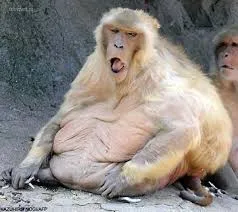Monkeys have always fascinated humans with their intelligence, agility, and social behaviors. Among the various species and individual monkeys that exist worldwide, one particular type stands out for its striking and unusual appearance—the albino monkey. Even more rare and captivating is the “fat albino monkey,” a term that sparks curiosity due to its combination of unique traits.
In this article, we’ll explore what makes the fat albino monkey so intriguing—from its genetics and physical characteristics to its behavior, habitat, and the challenges it faces.
What Is an Albino Monkey?
Albinism is a genetic condition characterized by a lack of melanin pigment in the skin, hair, and eyes. In monkeys, just as in other animals, albinism results in a pale or white appearance with pink or light-colored eyes. Albino monkeys are extremely rare because albinism is a recessive trait and often comes with health challenges, such as sensitivity to sunlight.
Albino monkeys have been documented in various species, including macaques, capuchins, and spider monkeys. Their striking white fur and pink eyes make them easily distinguishable from their non-albino counterparts.
The “Fat” Factor: Why Are Some Albino Monkeys Overweight?

The term “fat albino monkey” refers to an albino monkey that has a noticeably larger or overweight body compared to typical members of its species. While there is no specific species called the “fat albino monkey,” several factors could contribute to this condition:
1. Diet and Captivity
Monkeys kept in captivity, such as in zoos or sanctuaries, often have diets that differ from their wild counterparts. High-calorie foods or overfeeding can cause weight gain. In some cases, albino monkeys in captivity may become overweight due to limited physical activity.
2. Health Conditions
Certain metabolic or hormonal disorders can cause weight gain in monkeys, similar to humans. Albino monkeys, due to their genetic condition, may be more vulnerable to some health issues, including obesity.
3. Lack of Exercise
In the wild, monkeys are highly active, constantly climbing, jumping, and foraging. Captive albino monkeys with restricted space or limited stimulation may become less active, leading to weight gain.
Behavior and Personality Traits
Despite their unusual appearance, albino monkeys exhibit behavior and social patterns similar to their non-albino peers. They are intelligent, curious, and social animals that thrive in groups. However, due to their vulnerability, albino monkeys may sometimes be ostracized or face difficulties integrating fully with other monkeys.
A “fat albino monkey” in captivity may also display less energetic behavior, which can be both a cause and effect of their weight gain.
Challenges Faced by Albino Monkeys
Albino monkeys face several unique challenges:
- Sunlight Sensitivity: Lack of melanin makes albino monkeys highly susceptible to sunburn and eye damage, requiring careful management in captivity.
- Predation: Their conspicuous white coloring makes them easier targets for predators in the wild.
- Social Isolation: Their differences in appearance can lead to social rejection within their groups.
- Health Problems: Albinism can be associated with vision problems, immune deficiencies, and increased vulnerability to certain diseases.
Conservation and Ethical Considerations
Because albino monkeys are so rare and vulnerable, they are often subjects of fascination in wildlife reserves and zoos. Conservationists emphasize the importance of proper care, habitat protection, and education to ensure their survival.
Captive albino monkeys, including those who are overweight, need specialized diets and environments that encourage natural behaviors and physical activity. Overfeeding and limited movement can cause obesity, which further complicates their health.
Fun Facts About Albino Monkeys
- Albino monkeys have been documented in folklore and mythology in various cultures due to their unique appearance.
- Their pink eyes are caused by the visibility of blood vessels, which are normally masked by pigmentation.
- Albino monkeys can live just as long as their non-albino peers if properly cared for.
Conclusion
The “fat albino monkey” might sound like an unusual phrase, but it represents an intersection of genetics, biology, and animal welfare. Whether in the wild or captivity, albino monkeys require special attention and care due to their rarity and vulnerability. Understanding their unique needs helps us appreciate these incredible animals and supports efforts to protect them.
If you ever come across images or stories about a fat albino monkey, remember there’s a deeper story about genetics, environment, and care behind it. These rare animals remind us of nature’s diversity and the responsibility humans have in preserving it.
References
- National Geographic – Albinism in Animals
- Smithsonian’s National Zoo & Conservation Biology Institute – Primate Care and Conservation
- Journal of Wildlife Diseases – Studies on health impacts of albinism in primates
